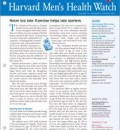 Harvard Men’s Health Watch, a newsletter published by Harvard Medical School, has released a special January 2013 issue focusing on rub-on relief for arthritis pain.
Harvard Men’s Health Watch, a newsletter published by Harvard Medical School, has released a special January 2013 issue focusing on rub-on relief for arthritis pain.
The authors advise that “Anti-inflammatory medications applied to the skin as creams, gels, sprays, or patches work best for mild to moderate pain near the surface.” They suggest that these remedies – which are not taken as a pill, but applied to the skin in the area of the pain – work best for localized pains in particular joints.
“Topical pain relievers can be very helpful for the more superficial joints like the knees, ankles, feet, elbows, and hands,” according to Dr. Rosalyn Nguyen, a clinical instructor in physical medicine and rehabilitation at Harvard Medical School, who was quoted in a news release issued by Harvard Health about the new publication. “In those areas, the medication can penetrate closer to the joint,” Dr. Nguyen says.
“For a localized problem with just one joint causing the pain, there’s no need for medication to travel throughout the body. A topical analgesic isn’t that helpful when pain emanates across an extended area, like the lower back,” according to the Harvard release.
Such pain relievers applied to the skin are called “topical analgesics.” According to the Harvard Health news release, “Prescription versions, which usually deliver nonsteroidal anti-inflammatory drugs (NSAIDs), come as creams, sprays, gels, or patches.”
“The active ingredient soaks in through the skin to reach the pain. In contrast, oral pain relievers flood the whole body with the medication after being absorbed in the gut,” Harvard Health explains.
“The most widely available prescription topical NSAID in U.S. pharmacies is diclofenac gel,” according to the Harvard news release.
Other, milder, non-prescription versions of topical analgesics mentioned by Harvard include over-the-counter products such as Icy Hot or Bengay. These products, Harvard says, “temporarily mask pain with a sensation of coolness or heat.”
“Other topical analgesics contain aspirin-like salicylates that have a mild anti-inflammatory effect. A third type contains capsaicin, the stuff that makes hot peppers so fiery. This substance overwhelms pain-sensing nerve circuits and masks the sensations from the underlying injury,” the Harvard release explains.
According to Harvard, topical analgesics may be particularly helpful for people who have localized arthritis pain and suffer gastrointestinal irritations when they take oral NSAID pain relievers, such as ibuprofen (Advil, Motrin), and naproxen (Aleve).
“When taken by mouth, as a pill or liquid, the NSAID is absorbed in the gastrointestinal tract. Then the drug travels in the bloodstream toward the source of the pain. But the blood also carries it to places that don’t need it. For example, an NSAID can cause stomach upset or even bleeding or ulcers,” Harvard says in an article entitled, “Get rub-on relief for arthritis joint pain,” published online.
“The ability to target pain more precisely helps to skirt the side effects of oral drugs.”
“If it’s a localized problem, with just one joint causing the pain, then there’s no need for a medication to travel throughout the body,” Harvard’s Dr. Nguyen says. “If the pain affects an extended area, like the lower back, or affects more than one part of the body, topical pain relievers may not be the best choice.”
The Harvard article cites a recent scientific review by the Cochrane Collaboration, an international body of health experts, which found that “some prescription topical NSAIDs offer the same pain relief as oral medications, but with fewer gastrointestinal concerns.”
Harvard cautions, however, that while a topical analgesic “concentrates the medicine near the pain site,” nevertheless, “a small amount does still enter the bloodstream.” “For this reason, topical NSAIDs may be off-limits to people at high risk for side effects,” Harvard warns. “This would include people with a history of ulcers or gastrointestinal bleeding.”
“I would still be reluctant to use an NSAID [with a history of ulcers or gastrointestinal bleeding], although the risk would be much less than it would be with oral formulations,’ Dr. Nguyen says.
More Information
For more information about topical analgesics, including the types and brands available, how their active ingredient NSAIDs work, limits on their use, and possible side effects, see the article by Harvard Health, Get rub-on relief for arthritis joint pain.
The more detailed January 2013 Harvard Men’s Health Watch Newsletter on Rub-On Relief for Arthritis Pain, is available for purchase online from Harvard Health Publications as a PDF document for $5.00.
For more information on Arthritis, Osteoporosis & Rheumatic Conditions, see the HelpingYouCare® resource pages on Arthritis, Osteoporosis & Rheumatic Conditions, including:
- Latest News
- What are these Conditions; Causes
- Symptoms & Diagnosis
- Prevention
- Treatments and
- Caregiving
_____________
Copyright © 2013 Care-Help LLC, publisher of HelpingYouCare®. All rights reserved.












AminoActiv makes a topical anti-inflammatory too. It’s non-prescription, safe, and it really helps relieve pain, usually within several minutes.